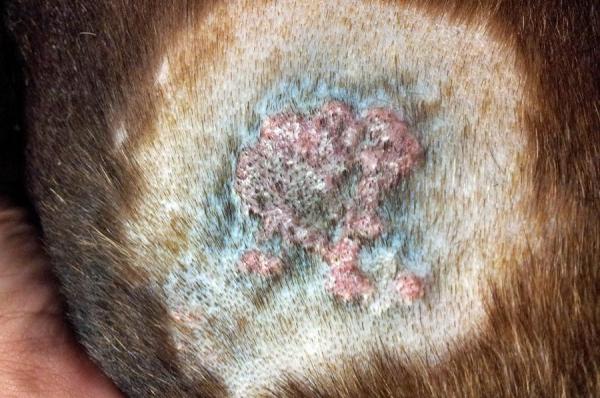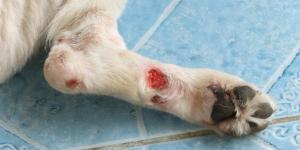Calcinosis Cutis in Dogs - Calcium Deposits in Dog Skin



See files for Dogs
Calcinosis cutis is a disorder characterized by the lesions of calcium salts in the skin. The result is the appearance of hard nodules or crusted plaques. In the canine medicine, it usually appears in individuals with Cushing's syndrome or those subjected to prolonged treatment with corticosteroids. There are other causes that can also cause the skin to break out in these lesions.
At AnimalWised, we provide everything you need to know about calcinosis cutis in dogs. We reveal the causes behind this relatively rare skin condition, as well as its concurrent symptoms and possible treatment options.
What is calcinosis cutis in dogs?
Calcinosis cutis is a skin lesion that occurs due to the abnormal deposition of calcium salts in the skin. Specifically, lesions are usually made of the mineral deposits known as apatites. This calcification can occur in different parts of the skin, including the dermis, the hypodermis or, more rarely, the epidermis.
It is usually a process that is associated with other health alterations or pathologies. We will describe these in more detail in the following sections. However, the actual pathological mechanism by which calcinosis cutis occurs is still unclear.
Types of calcinosis cutis in dogs
Calcinosis cutis in dogs is classified into 4 main groups depending on its cause:
- Metastatic: these are calcifications that occur in situations of hypercalcemia (high levels of calcium in the blood) on normal tissues.
- Dystrophic: these are calcifications that occur in situations of normocalcemia (normal levels of calcium in the blood) in tissues that have a previous injury.
- Iatrogenic: these are calcifications that occur as a result of some therapeutic treatments.
- Idiopathic: these are calcifications in which there is no demonstrable cause or factor, i.e. they have an unknown origin. They usually occur in dogs less than a year old.
There are other types of calcinosis in dogs, but they are usually variations of the above. For further information, take a look at our article on the various skin diseases in dogs.
Causes of calcinosis cutis in dogs
Now we know the nature of calcinosis cutis in dogs, we must explain its possible causes. They include:
- Hyperadrenocorticism: consists of increased levels of glucocorticoids in the blood. This is by far the leading cause of calcinosis cutis in dogs. Hyperadrenocorticism most often occurs for two main reasons, Cushing's syndrome in dogs or prolonged treatment with corticosteroids. Learn more with our article on corticosteroids for dogs.
- Chronic kidney disease (CKD): it is a pathology that causes hypercalcemia.
- Tissue lesions: including tumors, foreign bodies, areas of necrosis, purulent foci or parasitic foci.
- Calcium injections: as a side effect of the administration of calcium injection supplements.
In addition to these causes, we must not forget there are cases of idiopathic calcifications. These are cause of unknown origin which may or not be determined in the future.
Symptoms of calcinosis cutis in dogs
The main symptom is the growth of calcium deposits which form plaques on the skin. However, there are also other dermatological signs that can be observed in dogs with calcinosis cutis. These include the following:
- Foci of calcification may appear as hard, irregular nodules on the skin or as yellowish-white crusty plaques.
- The lesions are often accompanied by erythema (redness of the skin) and alopecia (hair loss).
- In some cases, the calcifications can ulcerate and discharge calcareous material . In these cases, the lesions often become infected and a pyoderma develops.
It should be noted that the most frequently affected areas in cases of calcinosis cutis in dogs are:
- Back
- Head
- Groin region
It is important not to confuse the calcified lesions which accompany calcinosis cutis in dogs. Take a look at our article on why my dog has pimples to learn some other causes.

Diagnosis of calcinosis cutis in dogs
To reach the diagnosis of calcinosis cutis, the following points are necessary:
- Anamnesis and clinical history: it is important to know if the animal shows other symptoms of disease or if they have undergone any treatment that may be the origin of calcinosis cutis.
- Examination of the lesions: as we have mentioned in the previous section, the disease can present in firm nodules to crusty plaques on the skin, usually in the back, head and groin areas.
- Biopsy and histopathological analysis: to reach the definitive diagnosis it is necessary to take a biopsy and perform a histopathological analysis of the skin lesions.
However, in addition to diagnosing the lesion (i.e. calcinosis cutis), it is important to identify its specific cause in order to establish a specific treatment. For this, other diagnostic tests may be necessary, such as blood and urine tests, laboratory tests, imaging tests, etc.
Read our related article to learn about understanding a dog's blood test.
How to treat calcinosis cutis in dogs?
Once the veterinarian has provided a positive diagnosis of calcinosis cutis in dogs, they will administer the following treatment:
- A specific treatment must be first established for the underlying pathology that has caused this injury. As there are idiopathic cases of calcinosis cutis that do not have a known cause, it is not feasible to establish a specific treatment. However, it should be noted this type of calcinosis usually resolves spontaneously in less than a year.
- In addition to specific treatment, it is important to treat possible complications of canine calcinosis cutis, such as pyoderma (bacterial skin infection). In these cases, it will be necessary to establish an antibiotic treatment and apply weekly baths with antiseptics (such as benzoyl peroxide).
- Small deposits are usually reabsorbed when the primary cause is removed and a specific treatment is instituted. However, larger deposits may require surgical removal.
Given the complexity of the treatment, it is essential to go to the veterinary clinic at the first symptom. This will both diagnose the problem and find the underlying cause that produces it.
This article is purely informative. AnimalWised does not have the authority to prescribe any veterinary treatment or create a diagnosis. We invite you to take your pet to the veterinarian if they are suffering from any condition or pain.
If you want to read similar articles to Calcinosis Cutis in Dogs - Calcium Deposits in Dog Skin, we recommend you visit our Skin problems category.
- Doerr, K. A., Outerbridge, C. A., White, S. D., Kass, P. H., Shiraki, R., Lam, A. T., & Affolter, V. K. (2013). Calcinosis cutis in dogs: histopathological and clinical analysis of 46 cases. Veterinary dermatology, 24:355-e79
- Joyce, J. (2011). Notes on Small Animal Dermatology. John Wiley & Sons.






 My approximately 11yr old 115lb Mastiff, Pitbull mix has just been started on medication for suspected Cushings disease but is still loosing muscle mass in his hind legs and now has open skin lesions, would like to connect with others in the same way. Do these look infected, I will be calling are very in the morning. Thank you
My approximately 11yr old 115lb Mastiff, Pitbull mix has just been started on medication for suspected Cushings disease but is still loosing muscle mass in his hind legs and now has open skin lesions, would like to connect with others in the same way. Do these look infected, I will be calling are very in the morning. Thank you

